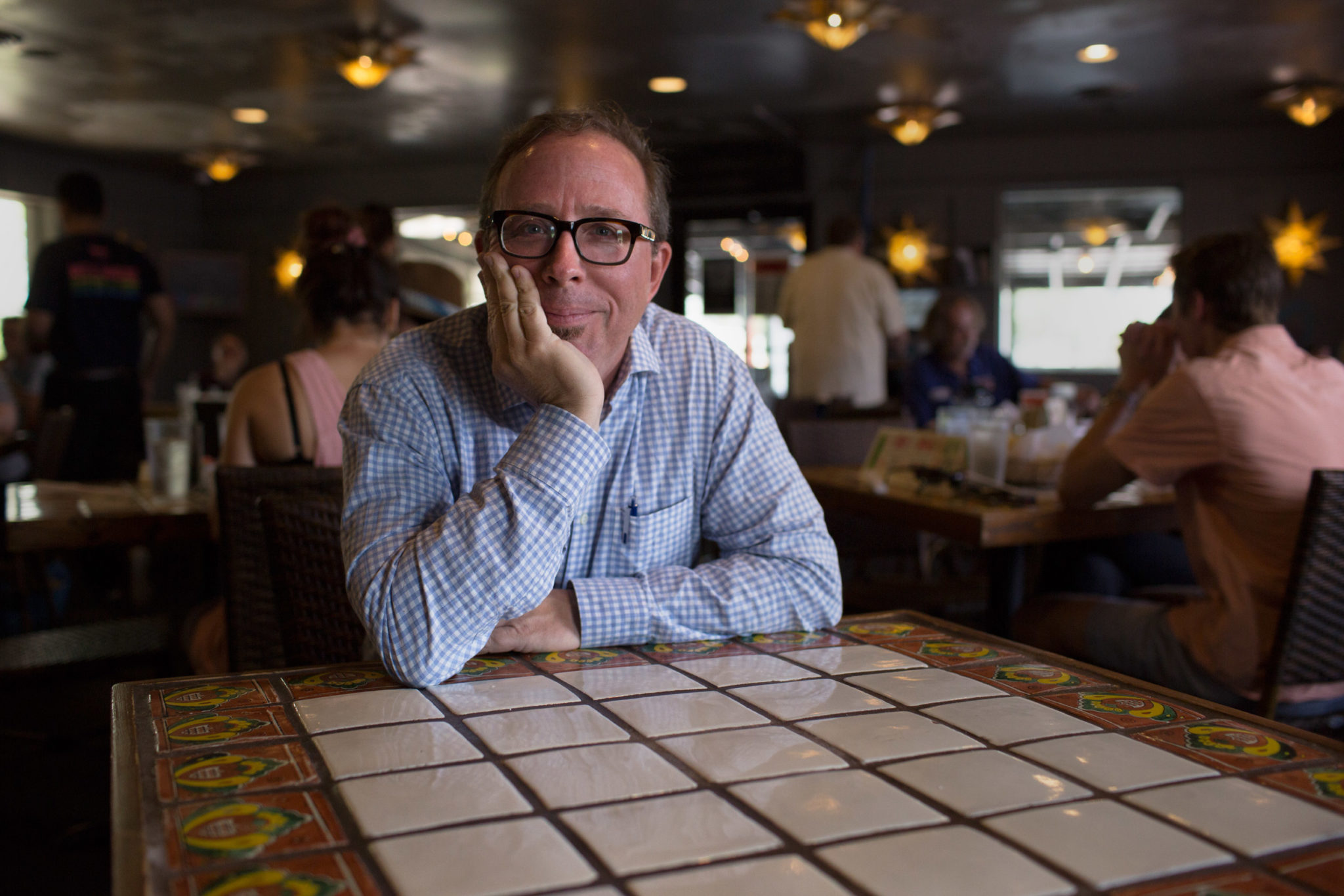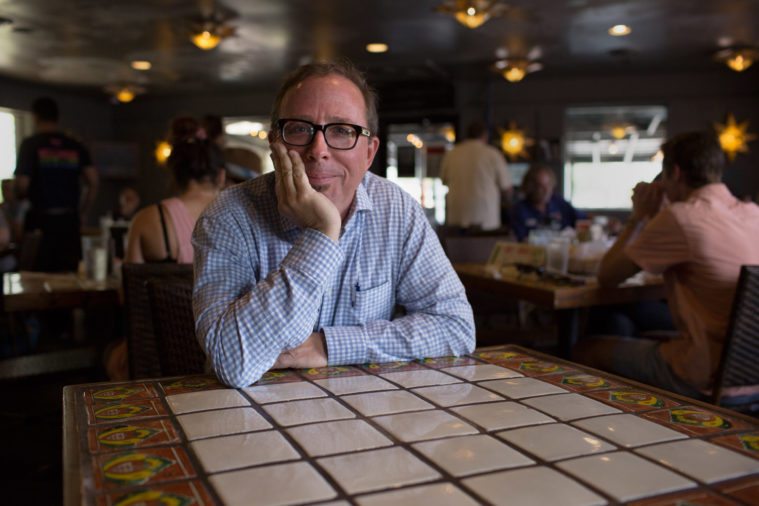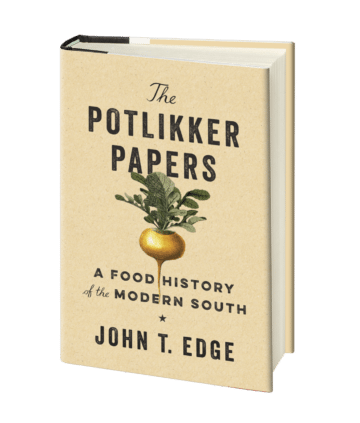
‘The Potlikker Papers’ Wants You to Eat Your Grits with a Side of Discomfort
John T. Edge’s new food history is an unflinching look at 60 years of racism and activism in the South.


John T. Edge is not the kind of food writer who waxes poetic about the decor of trendy new restaurants. Nor is he the sort who gushes over trends and worships at the feet of celebrity chefs. John T., as he’s known, will probably not tell you the “8 Coolest Spots for Poolside Sips,” and he most definitely will not ask if Paul Qui’s latest Instagram-ready venture can “offer redemption” to the “gentle and talented” celebrity chef, who was charged with assault last year.
No, in Edge’s universe the food leaders worth profiling are people like Pedro “Chingo Bling” Herrera, the Houston rapper whose first album, “The Tamale Kingpin,” dropped such lines as “making paper stacks / slinging masa like crack,” and Al Copeland, the New Orleans chef who named his fried chicken joint Popeyes because he couldn’t afford an apostrophe. Edge wants you to know about Booker Wright, the waiter who lost his job after telling NBC News about the racist vitriol he endured from diners, and Georgia Gilmore, the cook and midwife whose chicken dinners funded the Montgomery bus boycott.
The Potlikker Papers, Edge’s new tome on race, class and food politics in the South from the civil rights era to the present, is at its best when it delves into figures like these: activists, immigrants, chefs, hustlers and everyday people whose contributions have been largely cast aside by historians and writers. The book is named for the nutrient-filled broth left after cooking a pot of greens.
“Slave masters would often reserve the greens for themselves and deign to give the potlikker to the slaves, not knowing that the nutrients resided in the potlikker,” Edge says. “So the title is partly a metaphor for the process of writing a book. … It’s also a subversive response to white dominance.”
Edge’s work is complicated by the fact that, as a privileged white guy, he’s a product and a part of the same power structures he seeks to dismantle. He directs the Southern Foodways Alliance, a social justice-minded nonprofit that documents food culture, and he’s the bestselling author of more than a dozen books and hundreds of articles in the same vein. So complete is his success that other foodies have asked whether a voice like his should be “controlling the conversation.”

by John T.
Edge
PENGUIN PRESS
$28.00; 384 pages
But Edge is OK with those uncomfortable questions. He doesn’t shy away from them in The Potlikker Papers, and some of the book’s most riveting moments come when the tone shifts from scholarly to essayistic, as when he describes taking his son to a gift shop after visiting the Civil War battlefield at Vicksburg, Mississippi. During a similar excursion in his own childhood, Edge had taken home a Confederate gray soldier’s cap, but then-9-year-old Jess chooses a Union blue one instead. It’s a small but hopeful moment for a generation of young Southerners who may be finally facing up to their home’s ugly past. “The South of today demands more than … good guys and bad guys. More than blue and gray,” he writes. Amen to that.
The Texas Observer: You write, “I wanted to reconcile my profound love of the South with the deep anger that boiled in me when I confronted our peculiar history.” How do you deal with those competing impulses?
John T. Edge: I can only write through it and think through it and work through it. If you love a place without being critical of it, you’re not fully loving it. To celebrate the South without criticizing the South is to not fully apprehend it. I’m a white son of the South who takes great pride in the kind of biracial culture we’ve honed over time, and I’m really angry at decisions that politicians from Texas to Virginia have made, leading us toward division and bigotry. We’ve made a lot of mistakes over our history, and in a moment now that almost feels like a renaissance moment for the South, it’s the opportune time to face down the ills of our past.
The book is full of unsung heroes like Georgia Gilmore, the Montgomery activist who cooked for Martin Luther King Jr. and Robert Kennedy. What was so remarkable about her?
Georgia Gilmore’s cooking fueled a movement. The movers and shakers of the civil rights movement gathered at her oak trestle table, and that place became like an unofficial executive dining room for the civil rights movement.
She called people who came into her kitchen “heifer” and “whore.” Martin Luther King would walk in, and she’d say the equivalent of, “Come here, you little heifer, and get your black eyed peas!” I love the spirit of that. That kind of needling — it’s what you do when you know someone well. For a generation of African-American folk, kitchens like hers were places of comfort as well as sustenance.
Gilmore was also pretty radical. So she once pistol-whipped a store clerk for refusing to serve her grandson?
She did. Such power, such fierceness. There’s linkages between someone like Georgia Gilmore and [voting rights activist] Fannie Lou Hamer. A woman, seemingly without power, able to express great power. She had nothing to lose and everything to lose, and that’s kind of a metaphor for that moment in the civil rights movement. Bold, righteous women stepping to the fore to lead change in America and starting on her own block, in defense of her children, before beginning to push for change across the country.
You discuss how President Lyndon B. Johnson used the story of his African-American cook, Zephyr Wright, to help pass the Civil Rights Act. He brought her to a joint session of Congress and modified her story to suit his purposes.
JE: LBJ realized that he had to make the issue personal. He recognizes in the story of his fellow Texan the indignity she suffers on the roadways of the South, how she was unable to use a public restroom. LBJ describes himself as having an epiphany — and I believe he really did have that epiphany. I also believe he reframed the story for his audience, and that served him well.
Was that genuine, or was LBJ reducing her to a political prop?
I think it was real. He could genuinely care about her and also recognize her political value. Someone like Johnson could care deeply about Zephyr, be inspired by her, recognize in her humanity a prod for him to do better — and still do that while, perhaps, not paying her enough. It’s complicated and I make no excuses for it, but I recognize in his rhetoric a coming to terms with what Jim Crow demanded of both black and white Americans.
There’s a surprising first-person moment in the book. You’re writing about the Open House restaurant in Athens, Georgia, where Ku Klux Klan terrorists plotted the murder of [black Army officer] Lemuel Penn and other attacks. The cafe later became a hangout for University of Georgia frat boys, and you write, “I was one of those frat boys.”
I had as a boy gone with my father to one of the civil rights trials in Athens for the people who were accused of committing the murders. So I knew the story. And my father had sworn off the place. But I was too much of a dumbass, drunk-ass frat boy to reckon with it. So I did what so many did then, and I fear so many do now, which is to just choose to look the other way. And writing about it in that way, I’m trying to kind of critique myself. I think so many of us can choose to look away.
Including a lot of food writers.
[Laughs] You said it, not me. It’s true, we all look away. I hope with this book I can ask people to look more broadly and more deeply into this chapter of our history, and not be like me at that cafe.
The book ends in Houston in the modern day, with a focus on new immigrant chefs. What’s going on there?
Houston is my favorite city in America to eat in right now. If you look at the demographic destiny of the South and of the country, we’re gonna be a majority-minority nation by about 2060. So Houston to me is a place to kind of apprehend what our nation will look like.
If New Orleans was the Creole port city of the 19th century, Houston looks a lot like a 21st-century port city. Look at the Vietnamese crawfish cafes. In this moment of conversations about cultural appropriation, they subvert the whole thing. Vietnamese folks are appropriating Cajun food, which is kind of beautiful.
There’s a lot of talk about “the resistance” and the next generation of activists. What will the next Georgia Gilmore look like?
I don’t know that, but I do know so many people trying to do good work to fix our food system. I’m inspired by that, but I wish I heard more talk about people like Georgia Gilmore and Fannie Lou Hamer in the same breath. What they did is explicitly linked to what activists in their 20s and 30s are doing today, and I think that work today would have more resonance if we brought [civil rights-era activists’] work into relief. I don’t know who the next Georgia Gilmore or Fannie Lou Hamer is, I just want them to get their due now. Because I don’t think they’ve gotten it yet.
This interview has been condensed and edited for length and clarity.


